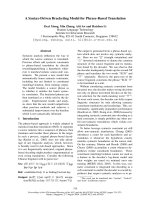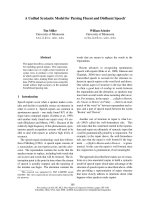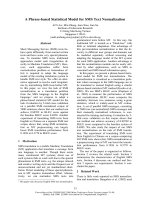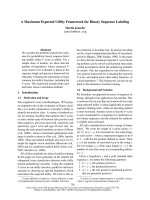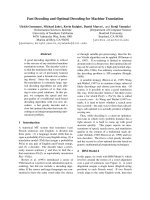Báo cáo khoa học: "A FRIENDLY AND FLEXIBLE FRONT-END FOR DATA MANAGEMENT SYSTEMS" pptx
Bạn đang xem bản rút gọn của tài liệu. Xem và tải ngay bản đầy đủ của tài liệu tại đây (269.58 KB, 4 trang )
EUFID: A FRIENDLY AND FLEXIBLE FRONT-END FOR DATA MANAGEMENT SYSTEMS
Marjorie Templeton
System Development Corporation, Santa Monica, CA.
EUFID is
a
natural language frontend for data management
systems. It is modular and table driven so that it can
be interfaced to different applications and data manage-
ment systems. It allows a user to query his data base
in natural English, including sloppy syntax and mis-
spellings. The tables contain a data management system
view of the data base, a semantic/syntactic view of the
application, and a mapping from the second to the first.
We are entering a new era in data base access. Computers
and terminals have come down in price while salaries
have risen. We can no longer make users spend a week in
class to learn how to get at their data in a data base.
Access to the data base must be easy, but also secure.
In some aspects, ease and security go together because,
when we move the user away from the physical character-
istics of the data base, we also make it easier to
screen access.
EUFID is a system that makes data base access easy for
an untrained user, by accepting questions £n natural
English. It can be used by anyone after a few minutes
of coaching. If the user gets stuck, he can ask EUFID
for help. EUFID is a friendly but firm interface which
includes security features. If the user goes too far
in his questions and asks about areas outside of his
authorized data base, EUFID will politely misunderstand
the question and quietly log the security violation.
One beauty of EUFID is its flexibility. It is written
in FORTRAN for a PDP-II/70. With minor modifications
it could run on other minl-computers or on a large com-
puter. It is completely table driven so ~hat it can
handle different data bases, different views of the same
data base, or the same view of a restructured data base.
It can be interfaced with various data management
systems currently it can access a relational data base
via INGRES or a network data base via WWDMS.
EUFID is an outgrowth of the SDC work on a conceptual
processor which was started in 1973. 1 It is now demon-
strable with a wide range of sentences questioning two
data bases. It is still a growing system with new
power being added.
In the following sections we will explore the features
that make EUFID so flexible and easy to use. The main
features
are:
• natural English
• help
• semantic tables
• data base tables
s mapping tables
s intermediate language
• security
i. NATURAL ENGLISH
EUFID has a dictionary containing the words that the
users may use when querying the data base. The
dictionary describes how words relate to each other and
to the data base. Unlike some other natural language
systems, EUFID has the words in the sentence related to
fields in the data base by the time the sentence is
"understood." More will be said about this process in
the section on semantic tables.
EUFID is forgiving of spelling and grammar errors. If
i~ does not have a word in the dlctionary t but has a
word that is close in spelling, it will ask the user if
a substitution can be made. It also can "understand"
a sentence even when all words are not present or ~ome
words are not grammatically correct. For example, any
of these queries are acceptable:
"What companies ship goods?"
"Companies?" (list all companies)
"What company shop goods?"
("shop" will be corrected to "ship". The plural
"companies" will be assumed)
Users are free to structure their input in any way that
is natural to them as long as the subject matter covers
what is in the data base. EUFID would interpret these
questions in the same way:
"Center shipped heavy freight to what warehouses in
1976?"
"What warehouses did Center ship heavy freight to
in 1976?"
Each user may define personal synonyms if tile vocabulary
in the dictionary is not rich enough for him. For
example, for efficiency a user might prefer to use "wh"
for "warehouse" and "co" for "company". Another user of
the same data base might define "co" for "count".
2. HELP
Basically, EUFID has only four commands. These are
"help", "synonym" (to define a synonym), "comment" (to
criticize EUFID), or "quit". These four commands are
described in the help module as well as the general
guidelines for questions.
If the user hits an error while using EUFID, he wlll
receive a sentence or two at his terminal which describes
the problem. In some cases he will be asked for clari-
fication or a new question as shown in these exchanges.
User: "What are the names of female secretaries'
children?"
EUFID: "Do you mean
(i) female secretaries or
(2) female children?"
User: "2"
or
User: "What is the salary of the accounting
department?"
EUFID: '~e are unable to understand your question
because "salary of department" is not
meaningful. Please restate your question."
If the description is not enough to clarify the problem,
the user can ask for help. First, HELP will give a
deeper description of the problem. If that is not
enough, the user can ask for additional information which
may include a llst of valid questions.
3. TABLES
EUFID is application and data base independent. Thls
independence is achieved by having three sets of tables
the semantic dictionary tables, the data base tables,
and the mapping tables which map from the semantic view
to the data base. Conceivably, a single semantic view
could map to two data bases that contain the same data
but are accessed by different data management systems.
91
3.1 SEMANTIC TABLES
The semantic view is defined by an application expert
working with a EUFID expert. Together the 7 determine the
ways chat a user mlghc want to talk about the data. From
this, a llsC of words is developed and the basic sentence
structures are defined. Words are classed as:
entitles (e.g.,
company)
events (e.g., send)
funcClons (after 1975)
parrs of a phrase or idiom (map coordlnaCes)
connectors (co)
system words (the)
anaphores (ic)
two or more of the above (ship an enClCy plus
ship an event)
An entity corresponds approximately co a noun and an
event co a verb. Connectors are preposlClons which are
dropped after the sentence is parsed. System words are
conjunctions, auxiliaries, and decermlners whloh partici-
pate in determining meaning buc do noC relate co data
base fields. Anaphores are words chac refer Co previous
words and are replaced by them while parsln 8. Basically
then, the only words chat relate co the items in the
data base are entities, events, and funcclons.
Entities and events are defined using a case structure
representation which combines synCacclc and sm clc
information. Lexlcal items which may co-occur with an
entity to form noun phrases, or wlch a verb co form
verb phrases, fill cases on the enClCy or event. Cases
are disclngulshed by the sac of possible fillers, the
possible connectors, and the syncactlc
position
of the
case relaclve co the antic 7 or event. A case may be
specified as opclonal or obllgacory.
A sense of an entlCy or event is defined by the sac of
cases which form a dlsCincC noun phrase or verb phrase
type. Three senses of the word "ship" are illustrated
in Figure
i.
~IPPING
CC~ANY I I
S~O~. aT"
SlIP
I-
-
OJL/Ga~aY
} 08~lcaT0aT ~
,m, I'~- "," I"~. 0~3/~m, AFro.
mI~rr
CASK F C~Jl G CASE C
IN =-
Figure I.
The flrsc sense of "ship" accounts for acClve voice
verb phrases wlch the pattern "Companies ship goods
CO
companies in year.*'
Examples
are:
Whac companies ship to Ajax?
In 1976, who shipped light freight co Colonial?
This sense of
"ship"
has ~wo obligatory cases, A and
C,
and ~ao optional cases B and H. The face chac the
"year"
case can
be
moved opclonally wichln the phrase
is noC represented within the case structure, buc is
recoEnlzed by the Analyzer, which assigns a structure
Co the phrase.
The second sense of "ship" accounts for the passive con-
8CrucClon of the type "Goods are shipped Co company by
company."
Examples are:
Was llghc frelghc shipped Co Ajax in 19787
What goods
were
shipped Co Ajax
by Colonial?
By
whaC
companies
in 1975 was
hesw/
freight
shipped
Co
Colonial?
Case O has the same filler as case B, but precedes
"ship" and is obligatory. Case g has the same filler
as case A, buc follows
"ship",
has a dlfferenc con-
nector, and is optional. That is, sense i of "ship"
is daflned as the associaclon of "ship" with cases
A,B,C. Sense 2 is the associ&clon of "ship" with cases
C,D,E. Sense 3 of "ship" describes the nominallzed
form "shlpmenc" and expliclCly captures the informaclon
Chac
shlpmencs involve
goods and
reflect transacClons
between companies.
An *~-mple is:
'~taC is the cransacclon number for the shlpmanc
of bolts from Colonial co Ajax?"
3.2 DATA BASE TABLES
The data base cables describe the data base as viewed
by the data management system. Since all dace mamags-
menC syscemn deal with dace iCmma organized into groups
chac are related through links, ic is possible co have
a co~n cable format for any dace management system.
The dace
bus
cables actually consist of two cables.
The CAN table contains information about
groups
and
dace iC ~a. A group (also called entity or record in
ocher systems) is Idenclfled
by
the group name. A
dare Icam in
che CAN cable
consists of
Che data
ices
"mine, che grOUp CO which IC belongs, a
uniC
code, an
output Idenclflar, and some field type informaClon.
Notably missing is anything about the byte wichln the
record or the number of bytes. ~UFID accesses the dace
base through s data management sysCom. Therefore, the
dace can be reorganized ~rLChou¢ changing the EUFID
cables aa long as the dace iCeml retain their names and
chair groupings.
The second data beam cable is the P~L cable which contains
an encz 7 for each group with its links co ocher groups.
For nscwork dace bases, cha link is the chain name for
the primary chain chac connects master and derail
records. For relational dace bases, every dace item
pair in the two groups chac can have the same value is
a potential link.
3.3 MAPPING TABLES
The mapping cablu cell the program how to gec from the
semantic nods, as found in the semantic dictionary, co
the dace base field names. Each entry in the mapping
table has a node name followed by two parts. The
first parr describes the pacCsrn of cases and their
fillers for chac node name. The second parr is called
a production and ic gives the mapping for each case
filler. A node may map co a node higher in the sentence
tree before iC maps co a dace bus item. For exalpls,
"company name" in the question '~at companies are
locacnd in Los Angeles?" may map to a group containing
ge~sral company ~n~ormacion. However, "company name"
in the question
"W~'mt companies
ship Co Los Angeles?"
may map to a group concain~ng shipping company information.
92
Therefore, it is necessary to first
map
"company name"
up to a higher node that determines the meaning. At the
point where a unique node is determined, the mapping is
made to a data item name via the CAN table. This data
item
name
is used in the generatlon of the query to the
data management system.
4. INTERMEDIATE LANGUAGE
EUFID is adaptable to most data management systems with-
out changes to the central modules. This is accomplished
by using an
intermediate
language (IL). The main parts
of EUFID analyze the question, map it to data items, and
then express the query in a standard language (IL). A
translator is written for each data management system in
order to rephrase the IL query into the language of the
data management system. This is an extra step, but it
greatly enhances EUFID's flexibility and portability.
The intermediate language looks like a relational re-
trieval language. Translating it into QUEL is straight-
forward, but translating It to a procedural language
such as WWDMS is very difficult. The example below shows
a question with its QUEL and WWDMS equivalent.
QUESTION: WHAT ARE THE NAMES AND ADDRESSES OF THE
EXECUTIVE SECRETARIES IN R&D?
INGRES
IL:
RETRIEVE
[JOB.EHFLOYEE,JOB.ADDRESS]
WHERE (DIV.NAHE = "R&D")
AND (DIV.JOB = JOB.NAHE)
AND (JOB.NAME = "SECRETARY")
AND (JOB.CLASS = "EXECUTIVE")
QUEL:
range of div is dlv
range of Job is Job
retrieve
(Job.employee,Job.address)
where dlv.name = "R&D")
and dlv. Job= Job.name
and
Job.name = "secretary"
and Job.class = "executive"
W~ IL:
RETRIEVE [JOB.EMPLOYEE,JOB.ADDRESS]
WHERE (DIV.DNAME
-
"R&D")
AND (DIV.DIV JOB CH - JOB.DIV_JOBCH)
AND (JOB.JNAME - "SECRETARY")
AND (JOB.CLASS - "EXECUTIVE")
WW'DMS QUERY:
INVOKE 'WWDMS/PERSONNEL/ADF'
REPORT EUFID-1 ON FILE 'USER/PASSWD/EUFID'
FOR TTY
QI. LINE "EMPLOYEE NAME
=",EMPLOYEE
Q2. LINE "ADDRESS "",ADDRESS
El.
RETRIEVE E-DIV
WHERE DNAME " "R&D"
WHEN R1.
R2. RETRIEVE E-JOB
WHERE
JNANE
- "SECRETARY"
AND CLASS - "EXECUTIVE"
WHEN R2
PRINT ql
PRINT Q2
END
5. SECURITY
EUFID
protects
the data
base by
removin B the user from
direct access
to
the data management system and data
base. At the most general level, EUFID will only allow
users to ask questions within the semantics that are
defined and stored in the dictionary. Some data items
or views of the data could be omitted from the dlctlonazy.
At a more specific level, EUFID controls access through
a user profile table. Before a user can use EUFID, a
93
system person must define the user profile. This cable
states which applications or subsets of applications are
available to the user. One user may be allowed Co query
everything that is covered by the semantic dictionary.
Another user may be restricted in his access.
The
profile table is built by
a
concept graph editor.
When a new login id is established for EUFID, the system
person gives the application name of each application
that the user may access. Associated with an applicatlon
name is a set of file names of the tables for the appli-
cation. If access is to be restricted, a copy of the
CAN and mapping function tables is made. The copies are
chanEed to delete the data items which the user is not
to know about. The names of the restricted tables are
then stored in the user's profile record. EUFID will
still be able to find the words that are used co talk
about the data item, but when EUFID maps the word to a
removed data item it responds to the user as though the
sentence could not be understood.
6. CONCLUSION
EUFID is a system that makes data base access easy and
direct for an
end
user so that he does not need
to
go
through a specialist or learn a language to query his own
data base, It is modular and table driven so that it can
be interfaced with different data management systems and
different applications. It is written in hlgh-level
transportable languages to run on a small computer for
maximum transportability. The case grammar that it
uses
allows flexibility in sentence syntax, ungrammatical
syntaxj and fast, accurate parsing.
If the reader wants more detail he is referred
to
refer-
ences 2-4.
7.
RE F~E~CES
1.
Burger, J., Leal, A., and Shoshanl, A. "Semantic
Based Parsing and a Natural-Language Interface for
Interactive Data Management," AJCL Microfiche 32,
1975, 58-71.
2.
Burger, John F. "Data Base Semantics in the EUFID
System," presented at the Second Berkeley Workshop
on Distributed Data Management and Computer Networks,
May 25-27
1977,
Berkeley, CA.
3.
Walner, J. L. "Deriving Data Base Specifications
from User Queries," presented at the Second Berkeley
Workshop on Distributed Data Management and Computer
Net-works, May 25-27,
1977,
Berkeley, CA.
4.
Kameny, I., Welner, J., Crilley, M., Burger, J.,
Gates, R., and Brill, D. "EUFID: The End User
Friendly Interface to Data Management Systems," SDC,
September 1978.


